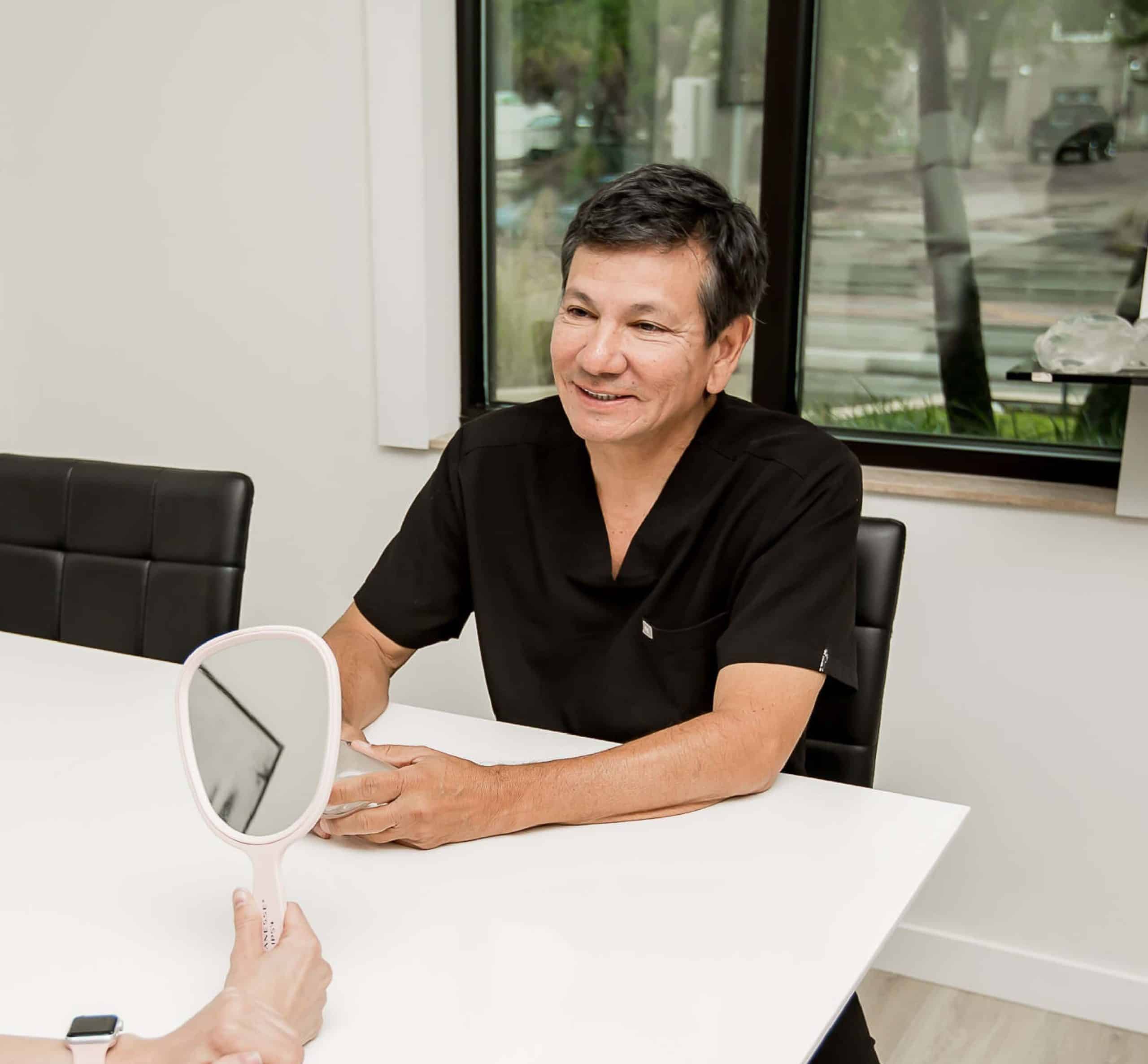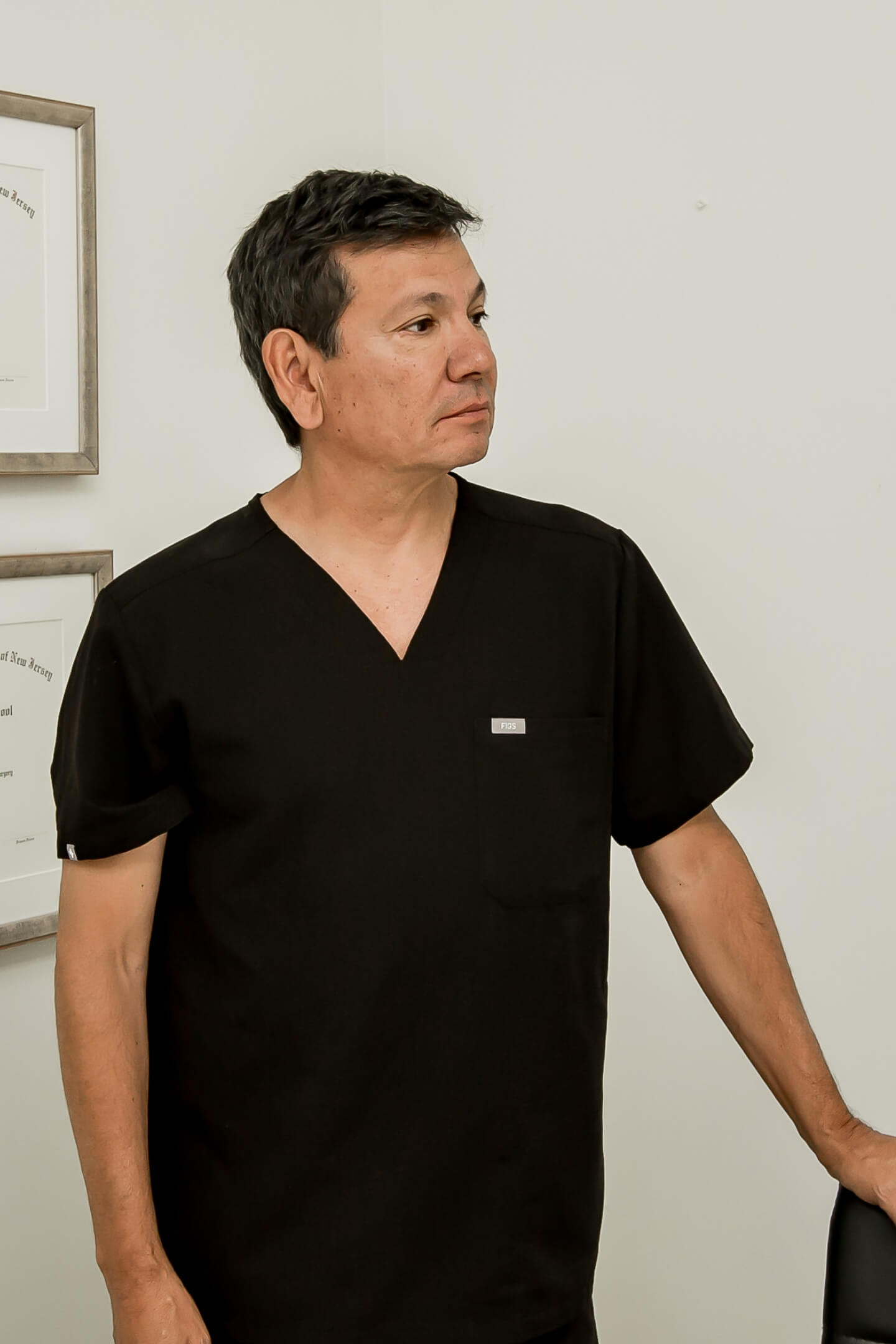Breast Augmentation in Tampa, FL
Contact Model
Model
Women worldwide have an ideal image of themselves and, in many cases, have the disposable income and inclination to reach that objective. Are you dissatisfied with your breast size or shape? Many women desire breast enhancement, whether this sentiment developed in young adulthood or after weight loss, pregnancy, or childbirth.
Breast augmentation can help you achieve the feminine beauty associated with voluptuous, perky breasts. It can improve your appearance and dramatically boost your self-confidence.
What Is Breast Augmentation?
Breast augmentation procedures aim to increase the size of the breasts with implants. This procedure can also restore breast volume after weight loss, pregnancy, or mastectomy, as well as correct asymmetry and achieve a change in shape or projection.
This surgery has a high satisfaction rate, giving most women an increase in self-esteem and improved overall quality of life. In fact, a study published in the Journal of Family Medicine and Primary Care reviewed the effects of breast augmentation and found the surgery resulted in significant improvements in sexual well-being, psychosocial well-being, and breast satisfaction.
Who Is a Candidate for Breast Augmentation?
Dr. Perez evaluates many factors when assessing breast augmentation candidacy. His detailed consultations help ensure the procedure is the right choice for your needs and goals. When analyzing your candidacy, he will look at the following:
Health
An ideal candidate for breast implants is in good overall health, free from medical issues like heart conditions, breast cancer, and other illnesses like diabetes and auto-immune diseases that can make the procedure unsafe.
Allergies
Patients should undergo an allergy screening for materials used in their breast implants to ensure they will not have an adverse reaction during or after their procedure.
Pregnancy
Being pregnant, breastfeeding, or planning to become pregnant makes someone an unsuitable candidate for breast augmentation because their body is subject to changes that would interfere with the intended results of breast augmentation.
Expectations
In addition to the physical qualifications described above, a good breast augmentation candidate should have realistic expectations about what the procedure can and cannot do, especially when performed by a surgeon with a conservative approach like Dr. Perez.
Allow Our Expert to Evaluate Your Candidacy
Far too often, women self-disqualify from plastic surgeries they would actually be good candidates for. Instead of trying to make medical determinations on your own, you can rely on our double-board-certified surgeon to assess your potential for breast augmentation.
 Model
Model
How Is Breast Augmentation Performed?
Breast augmentation is an outpatient procedure performed under general anesthesia. Generally, it includes the following four steps:
Step 1: Total Numbing
The procedure begins with the administration of general anesthesia, which ensures you will feel no pain during your procedure and have no memory of it afterward.
Step 2: Accurate Incisions
Dr. Perez performs incredibly precise incisions into the breast tissue, creating a pocket for implant placement that is typically under the pectoral muscles.
Step 3: Implant Placement
Dr. Perez places your implants and positions them according to his prepared plan for the best aesthetic results following surgery.
Step 4: Recuperation Prep
Our surgeon sutures your incisions closed, wraps your breasts in special bandages that promote healing, and provides a specialized bra.
We Offer Virtual Consultations for Your Convenience
Dr. Perez is proud to offer virtual consultations so you can discuss your cosmetic goals and learn about treatment options from the comfort of your home.
 Model
Model
What Are My Breast Implant Options?
Dr. Perez offers both silicone implants and saline implants to his patients. Determining which of the two options is right for you can be complex; thankfully, Dr. Perez is here to guide you through each step of your breast augmentation journey.
Saline Implants
Saline breast implants are made of a silicone shell and filled with a sterile saline solution after insertion. Saline implants require smaller incisions than silicone implants and are also more affordable. In the rare case of breast implant rupture, the saline dissolves harmlessly into the body. While these advantages are notable, Dr. Perez primarily places silicone breast implants for the many benefits they offer.
Silicone Implants
Silicone breast implants are made of a silicone shell filled with a silicone gel. Compared to saline implants, silicone breast implants provide a more natural shape and organic feel. Unlike saline, silicone gel has no known human allergies. Modern silicone implants have a double-walled shell to help prevent leakage. If a rupture does occur, these implants will not deflate like saline.
What Are My Breast Augmentation Incision Options?
Different incisions mean different scars, which is usually why a patient desires one over another. These incision options have various pros and cons, although all can achieve beautiful results. You will have a chance to discuss your options with Dr. Perez, and he will advise you on which incision will work best for your specific anatomy and goals.
Inframammary
Inframammary incisions are placed in the natural crease at the bottom of your breast. This is the most common incision for breast augmentation, as it provides better visibility and access for a smoother operation. It also comes with the fewest risks for complications like capsular contracture.
Periareolar
Periareolar incisions are placed along the bottom perimeter of the areola (the darker-colored skin surrounding the nipple). This incision location comes with risks, such as capsular contracture and loss of sensation. Smaller areolas are less eligible for this incision.
Transaxillary
This incision is placed in the armpit, with the benefit that there won’t be scars on the breasts at all. It comes with risks such as capsular contracture and implant malposition.
What Are My Breast Implant Placement Options?
Generally, there are two options for placement of the breast implants—either over or under the chest muscle.
Over the Muscle (Subglandular Placement)
With subglandular placement, the breast implants are placed below the breast tissue but above the pectoralis muscle. This placement may be suitable for those with an adequate amount of breast tissue to cover the implant but poses the risk of visible rippling.
Under the Muscle (Submuscular Placement)
With submuscular placement, the breast implants are placed below the breast tissue and below the pectoralis muscle. This placement option provides more coverage and reduces the risk of visible rippling. This patient is ideal for patients with very little natural breast tissue.
 Model
Model
contact us online or call Dr. Perez
(813) 877-3739Combining exceptional surgical skills and an eye for beauty, Dr. Jaime Perez strives to enhance the natural features of his patients. When you trust your cosmetic needs to a dedicated and experienced plastic surgeon like Dr. Perez, you can feel confident that you will enjoy the highest standard of care and the most natural-looking and long-lasting results.
Schedule A Consultation
What Is Breast Augmentation Recovery Like?
Immediately after surgery, you will be monitored for about an hour before you are discharged home. You will be wearing a surgical bra and given postoperative instructions to follow.
You will need to take one week off from work and avoid strenuous activities for one to two weeks. You will experience some swelling and discomfort, but this will be easily managed with over-the-counter medication. After a month, all side effects should subside.
How Soon Will I See My Breast Augmentation Results?
Your breasts will be noticeably larger right after surgery, but it will take a few weeks for the swelling to subside so you can see your early results. After six months, you should be fully healed, and just one year after surgery, your incisions should be virtually impossible to notice.

Why Choose Plastic Surgery Center of Tampa for Your Breast Augmentation?
Patients throughout Tampa, FL, and all over the country come to board-certified plastic surgeon Jaime Perez for augmentations for his vast skill, extensive experience, and compassion.
Many plastic surgeons place overly large breast implants that strain the tissues, causing problems within months. In contrast, Dr. Perez delivers breast augmentations designed around your unique proportions and anatomy. When you come to his office in Tampa, FL, you can receive breast implants that are precisely tailored to your height, weight, and figure. His conservative, frame-respecting approach provides just the right level of aesthetic enhancement.
Book A ConsultationBreast Augmentation FAQ
Changing Lives in Tampa, FL
-
Dr. Perez provides personalized instructions to help patients prepare for a safe, effective breast augmentation surgery. Guidelines he gives to each patient include:
- Stopping the use of self-tanning products to minimize the risk of infection.
- Avoiding alcohol for one week before your surgery.
- Stopping all blood thinners, such as aspirin, for two weeks before surgery.
- Refraining from all nicotine products for one month before surgery.
-
A breast augmentation on its own cannot address severely sagging breasts. Combining breast augmentation with a breast lift can enhance shape, size, firmness, fullness, and perkiness. Many patients pair these two procedures at our Tampa practice.
-
According to the American Society of Plastic Surgeons, the average cost of breast augmentation surgery in 2022 was $4,294, but this only includes the surgeon’s fee, which can vary significantly based on the surgeon’s skill and geographical location. Additional fees include anesthesia, facility charges, and the cost of the implants.
Dr. Perez starts his breast augmentation pricing at $6,500, which means you can receive luxury breast implants from a triple-board-certified surgeon at an affordable cost, as his pricing includes everything from start to finish. Dr. Perez’s pricing is another reason so many patients choose him for their breast augmentation surgery.
-
Unfortunately, breast augmentation is a cosmetic surgery and not covered by insurance unless it is performed for a medical reason, such as breast tissue restoration following a mastectomy.
Payment for breast augmentation is due two weeks before surgery. Dr. Perez accepts all major credit cards, including Visa, Master Card, American Express, and more. He also offers financing to help patients manage their out-of-pocket costs, including CareCredit®, which allows patients to receive low to no-interest medical loans or financing for their procedure.

Interested in Breast Augmentation in Tampa, FL?
We’d love to assist you on this exciting journey! Schedule a consultation with Dr. Perez today to discuss your goals. You can use our online contact form or call us at (813) 877-3739.
We look forward to hearing from you.
Patient Testimonials
Around 7 months post breast augmentation and could not be any happier with the result! Dr. Perez did such an incredible job and the staff at the facility made me feel comfortable and at ease before, during and after my surgery. I cannot say enough great things about this facility, highly HIGHLY recommend!
Best doctor ever . He’s the best. Amy surgery was breast augmentation. my recovery was quick, and I never had any pain. Thank you so much
I had 32a cups, and was very embarrassed. I’m 22 and wanted a breast augmentation for as long as I can remember. I was very scared with it looking unnatural as I’m 100 pounds. Jaime Perez calmed my fears and said he will refuse to put on anything that will look unnatural. After the surgery, I was beyond happy. Nobody can tell they are fake, and my friends were in shock with how amazing and real they look. I am so happy that I even scheduled a rhinoplasty for December with him. I highly recommend!!!

Start Your Transformation Today
Tampa Office
307 S MacDill Ave.
Tampa, FL 33609
